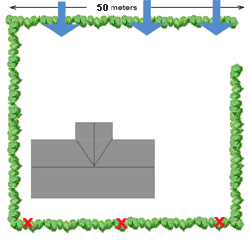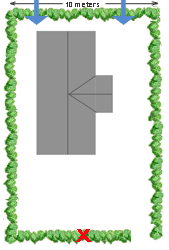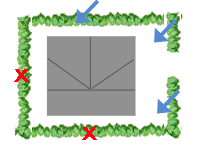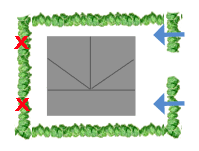Setting and positioning wasp traps
How many wasp traps do I need?
The amount of traps needed to cover the area you are trying to protect depends on the size of the area in question. It would be unreasonable to expect one trap to cover the size of a football pitch for example. The shape of the area in question is also a factor in how many traps are needed.
A smallish garden which is square or round will only need one or two traps to protect it, but a larger garden will obviously need more. The more traps you use, the greater the protection will be as the traps will intercept more scout wasps which are looking for food.
Take a look at the scenarios which will give you an idea of how many traps you will need to protect your property.
The images are just a guide to give you an idea of how many traps you will need to cover your location.
The blue arrows represent the prevailing wind direction.
The red x's represent the number and location of wasp traps.
Wasp traps can be used suspended from trees or any other elevated positions, depending on the type, they can normally be used free standing.
Wasp traps can be used to combat numbers of wasps from a nest that cannot be located or where a nest is unreachable. The trap can also be used as a protective perimeter to safe guard an area such as an orchard.
Scenario 1

Scenario 2

Positioning the Wasp Trap.
Positioning of the wasp trap is crucial to its overall performance. The trap should be sited downwind of the area to be protected. The prevailing wind should hit the area to be protected before it hits the wasp trap. The odour from the trap is then blown in the wind and any scout wasps out hunting (wasps hunt into the wind) will pick up the scent from the traps.
The optimum location for the wasp trap is a quiet, sunny location which has a breeze to carry the scent from the trap.
When protecting fruit crops, the wasp trap should be positioned amongst the tree or plant itself.
Take a look at the scenarios below which will give you some ideas on where you can position your traps in regards to your area.
The images are a guide to you an idea of where to position the wasp traps.
The blue arrows represent the prevailing wind direction.
The red x's represent the position of the wasp traps.
Scenario 1

Scenario 2
